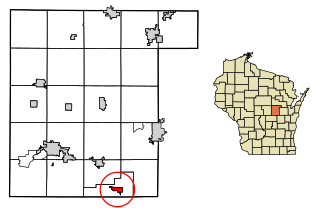
Nasewaupee is a town in Door County, Wisconsin, United States. The population was 2,061 at the 2010 census. The unincorporated community of Idlewild is located in the town, as is Sherwood Point Light and Potawatomi State Park.

Carlton is a town in Kewaunee County, Wisconsin, United States. The population was 1,014 at the 2010 census. Carlton is probably named for James Carlton, an early settler in the area.

Kewaunee is a city in Kewaunee County, Wisconsin, United States. The population was 2,837 at the 2020 census. Located on the northwestern shore of Lake Michigan, the city is the county seat of Kewaunee County. Its Menominee name is Kewāneh, an archaic name for a species of duck.

Glendale is a city in Milwaukee County, Wisconsin, United States. It is a suburb of the neighboring Milwaukee. The population was 13,357 at the 2020 census.

River Hills is a village in Milwaukee County, Wisconsin, United States. The population was 1,602 at the 2020 census.

Woodville is a village in St. Croix County, Wisconsin, United States. The population was 1,344 at the 2010 census.

Addison is a town in Washington County, Wisconsin, United States. The population was 3,341 at the 2000 census. The unincorporated communities of Addison, Allenton, Aurora, Nenno, and Saint Anthony are located with the town. The unincorporated community of Saint Lawrence is also located partially in the town.

Polk is a town in Washington County, Wisconsin, United States. The population was 3,938 at the 2000 census. The unincorporated communities of Ackerville, Cedar Creek, Cedar Lake, Diefenbach Corners, Mayfield, and Rugby Junction are located in the town. The town derives its name from James K. Polk, 11th U.S. president, who was in office when the town incorporated in 1846.

Richfield is a village in Washington County, Wisconsin, United States. The population was 11,739 at the 2020 census. The unincorporated community of Hubertus, as Well as the Former Communities of Pleasant Hill and Plat are located in the village, as well as the communities of Colgate and Lake Five, which are partially located in Richfield.

Slinger is a village in Washington County, Wisconsin, United States. The population was 5,992 at the 2020 census.

Wayne is a town in Washington County, Wisconsin, United States. The population was 2,182 at the 2020 census. The unincorporated communities of Kohlsville and Wayne are located in the town.

Ogdensburg is a village in Waupaca County, Wisconsin, United States. The population was 185 at the 2010 census.

Mukwonago is a village in the U.S. state of Wisconsin. The population was 8,262 at the 2020 census. The village is located mostly within the Town of Mukwonago in Waukesha County, with a small portion extending into the Town of East Troy in Walworth County. Of its population, 8,040 are in Waukesha County and 222 are in Walworth County.

Stockbridge is a village in Calumet County, Wisconsin, United States. The population was 678 at the 2020 census. The village lies within the Town of Stockbridge.

Mount Hope is a village in Grant County, Wisconsin, United States. The population was 225 at the 2010 census. The village is located within the Town of Mount Hope.

Mishicot is a town in Manitowoc County, Wisconsin, United States. The population was 1,409 at the 2000 census. The Village of Mishicot is located within the town. The unincorporated communities of Fisherville, Kingsbridge, and Tisch Mills are also located partially in the town.

Mosinee is a city in Marathon County, Wisconsin. It is part of the Wausau, Wisconsin Metropolitan Statistical Area. The population was 4,452 at the time of the 2020 census.

Germantown is a village in Washington County, Wisconsin, United States. The population was 20,917 at the 2020 census. The village surrounds the Town of Germantown. In July 2007, Germantown was ranked the 30th most appealing place to live in the United States by Money Magazine.

Kewaskum is a village in Washington and Fond du Lac counties in Wisconsin, United States. The population was 4,004 at the 2010 census. All of this population resided in the Washington County portion of the village. The village is mostly surrounded by the Town of Kewaskum.

Fremont is a village in Waupaca County, Wisconsin, United States. It is surrounded by Town of Fremont. The population was 679 at the 2010 census. Fremont has been referred to as the "White Bass Capital of the World."























